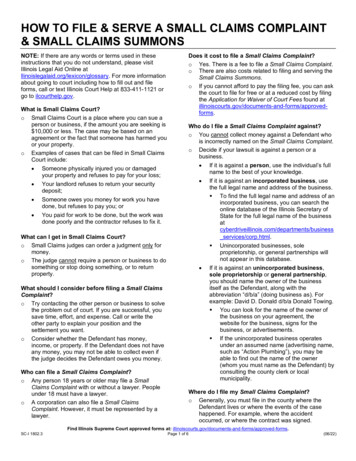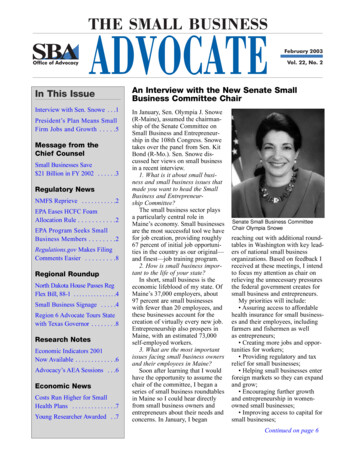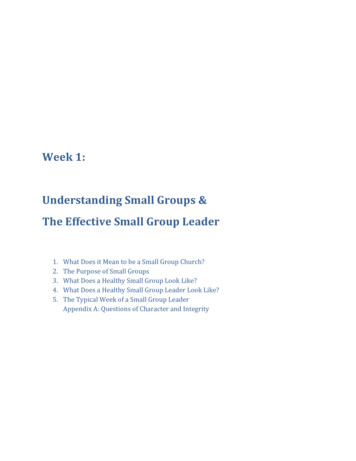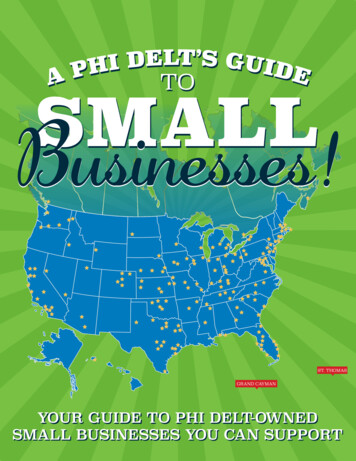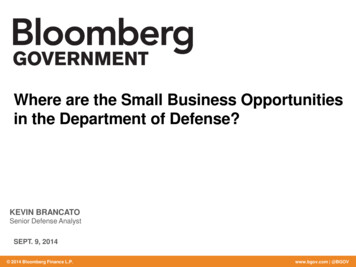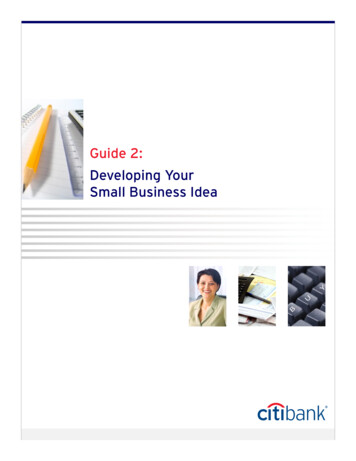
Transcription
Guide 2:Developing YourSmall Business Idea
Guide 2: Developing Your Small Business Idean INTRODUCTIONWelcome to the Citibank Small Business information guide series. This is one of tenguides that have been developed just for you, a person who is thinking about starting asmall business or who has made the commitment to start one. It is targeted to peoplewho are considering starting a small business as well as small business owners whowant to learn more about successful strategies and skills. Citibank worked with a teamof small business owners like you to develop, write, and produce this series. All of usknow how important it is to have clear and concise information to make smart businessdecisions. Our goal is to share experiences about the dynamic, exciting small businesscommunity.Did you ever see a new product and say to yourself, “Why didn’t I think of that?!”This guide willhelp you identifyyour own skillsas they relate tosmall business.Maybe you did think of that new product idea but you just didn’t follow through withDeveloping Your Small Business Idea.Even so, your curiosity is a definite asset — and reading this guide could be your firststep toward Developing Your Small Business Idea the next time inspiration strikes.The ten guides in this Citibank Small Business information series were written justfor you. Every guide focuses on a specific subject that has been researched and writtenby small business owners who want to share their insights and experiences with you.Developing Your Small Business Idea shows you how to spot opportunities and takeadvantage of them.Developing Your Small Business Idea will help you to: be alert to new business opportunities. identify your personal skills and creativity related to small business. analyze the commercial potential of a business opportunity.Guide 2: Developing Your Small Business Ideapage
Does this sound exciting? It is! Let’s get started right now. The first step is to look fornew business opportunities.n OverviewNew business opportunities are everywhere. Just ask the 25 million owners of smallbusinesses in the U.S. today. Every one of these entrepreneurs saw a niche, thought upa new idea, and took a chance to build a business where there was none. You can too.These are the basic skills and resources you need to begin: An interest in new ideas — the same curiosity that encouraged you to choosethis guide can serve you well in looking for new business ideas Imagination — the ability to see what’s there and what could or should be there Time — to think, research, analyze, ask for advice, make decisions, testThere are about25 million smallbusinesses acrossthe United States.them and change your mind; remember that time definitely is a friend of theentrepreneur take just as much as you need to put your best ideas to work Talent — the basic abilities you need to do or manage the business tasks Dedication — a stick-to-it discipline and an awareness that there may besurprises, both good and bad, on the road aheadNotice anything? Most of these items are character traits. Some people have themnaturally while others have to focus on developing them. It’s a fact that these qualities,which any person can have or develop, combine to give a new business owner the keysto success.Take a few minutes to look through this guide now. You’ll get a good idea of the stepsinvolved in Developing Your Small Business Idea. Make a copy of all the worksheetsso you have them handy when you start your research and set your goals.Guide 2: Developing Your Small Business Ideapage
I. Start Looking for New Business IdeasIf there were a School of New Business Ideas, it would be right in your backyard, nextdoor, down the block, or at your closest mall. Start looking. You will be amazed howmany new business ideas you can find:Examples:The new pizza shop lets you e-mail or fax in an order anytime of the day or night andset a time for delivery within 24 hours. Ask Yourself: How could I simplify contact with customers in my new business?Your auto mechanic opens at 6:30am and offers drop-off and pick-up service to thecommuter train. Ask Yourself: What special service could I offer my customers?New businessideas may be rightin front of you.Look around forinspiration.A party planner sends electronic bills to you that can be paid online. Ask Yourself: How could I use technology to make my new business work moreefficiently and provide more convenience for my customers?The new wine store makes shopping quicker with color display bins: Spanish wines inorange; California wines in bright purple; French wines in blue. Ask Yourself: How could I use design or color to help my customers to makechoices efficiently and make my business space look more interesting?An interesting observation — none of these examples is an idea for a new business,but all of them are examples of unique features or qualities of a business. That’s animportant lesson: There are many clever, creative tactics used by other small businessowners that you can use too.Now is a good time to develop the habit of observing what works, so you can adaptthe best strategies for the advertising, staffing, design, or customer service of your newbusiness idea. Concentrate on how you can do more, better, faster, or less expensiveGuide 2: Developing Your Small Business Ideapage
than your competition. It can be your strategic advantage, as well as the first and mostimportant step to success.What is a Small Business?Small businesses come in all sizes and shapes. In fact, a small business can be quitelarge. The U.S. Small Business Administration (SBA) defines a small business as anindependent concern with less than 500 employees. Here are some interesting andimportant facts about small businesses in the U.S. today: 99.7% of all firms that have employees are small businesses 50% of all the employees in the private sector work for small businesses 53% of small businesses are home-based, 3% are franchises small businesses received more than 69 billion in federal contracts in 2004 10.6 million businesses are at least 50% owned by women, generate53% of smallbusinesses in theUnited States arehome-based. 2.5 trillion in revenues, employ more than 19.1 million workers, with a 546 billion payrollFor more information about small businesses, go to http://ww.sba.gov, and theNational Association of Women Business Owners website, http://ww.nawbo.org, andhttp://ww.citibank.com/us/citibusiness. You can learn about the various types andsizes of small businesses, emerging new business trends, Small Business Empowermentprograms that provide funding and other support for start-up companies, andmuch more.II. Identify Your Skills and Creativity Related to New BusinessOpportunitiesYour new business opportunity might be in your own hands. Think about yourhobbies, favorite activities, or business skills. Could any of them be the basis for anew business?Guide 2: Developing Your Small Business Ideapage
Use this checklist to compare the opportunities.Checking Out New Business OpportunitiesHOBBIESRate your skill10 excellent1 poorAble toproduceto sell?Can find talentedpeople to createproduct? What?Is there /BakingWoodworking,FurniturerefinishingCraftsHome DecoratingParty PlanningGardeningCollecting, onlinesalesBUSINESS SKILLSComputer cesMarketingGuide 2: Developing Your Small Business Ideapage
HOBBIESRate your skill10 excellent1 poorAble toproduceto sell?Can find talentedpeople to createproduct? What?Is there g,/tutoringPhysical/sportstrainingWritingPainting, artwork,muralsLanguages,translation orteaching Ask Yourself: What does this checklist show me about my hobbies or skills thatcould be the basis for a new business?III. Think Strategically about New BusinessesStrategic thinking helps you explore new business ideas. Start with a goal orobservation. Can you solve a problem, beat deadlines, and take advantage ofopportunities created by news or events? Examine each possibility below.n Solve a ProblemHave you had a difficult time with a project lately? Maybe other people have too. Thatcould help you identify a great new business idea. Example: Doris makes sense out of health insurance claims.Doris did public relations for a major research hospital. Before that, she worked in theclaims department of a healthcare insurance company. When she was looking for newbusiness opportunities, she remembered the problems people had with health insuranceclaims:Guide 2: Developing Your Small Business Ideapage
the hospital expected to be paid promptly for services; if payment was notreceived on a timely basis, duplicate bills and perhaps past-due charges wereadded. the insurance company needed to receive accurate claims forms in order toprocess and pay claims promptly. patients often were unable or unwilling to check all bills for accuracy andcomplete the insurance forms promptly. family members who received billing statements many weeks or months aftertreatment did not know where or how to get the correct details needed tocomplete the insurance claims forms.Doris started her own business to help patients understand where and how to findthe information and forms needed to get health insurance claims paid promptlyPeople are oftenwilling to pay athird party tosimplify a complextask for them.and accurately. Often, she works with the hospital, the insurance company, and thepatient and/or the patient’s family to get claims settled promptly. Her services help thehospital, the insurance company, and the patient. Example: AuctionDrop.com took the hassle out of online selling.Almost all of us have something around the house or office we want to sell. Onlineselling is convenient, but many people think it’s complicated. AuctionDrop makes iteasy: it networked with UPS to create over 4,000 dropoff locations around thecountry. items for sale are shipped to AuctionDrop, with no charge to the customer, tobe photographed, researched, priced, and posted on eBay. the company has more than 30,000 items for sale, including computers andnetworking equipment, collectibles, jewelry, accessories, musical instruments,audio and video equipment. AuctionDrop takes a percentage of each sale, the seller gets a check for thesale, and the buyer gets a product conveniently and at a good price.Guide 2: Developing Your Small Business Ideapage
Ask Yourself: Can I think of a problem I could solve by creating a new business?n Beat the DeadlinesThink of all the products or services that are time-sensitive. That is, after a certain dateor time, their value expires. Examples: priceline.com, orbitz.com, expedia.com — all sell travel reservations andalso sell last-minute trips. These are the airline tickets or hotel accommodations thathave no value after a certain date. Other Examples: gift certificates, theater seats, school or college classes, tickets tosports events, frequent flyer miles, coupons Ask Yourself: Is there any way I can set up a trading system to help buyersWhere there aretime-sensitiveneeds to fill, thereis a businessopportunity.access these values before they expire?n Find Products in Short SupplySometimes, a product reaches the market before production is increased to meet asurprise demand. Cabbage Patch Dolls, Beanie Babies, new PlayStation games areexamples.Personal shoppers also can help find products for shoppers with a particular need. Examples: a career wardrobe for a plus-size woman, sport clothes for an elderly manwith arthritis who has difficulty with buttons and zippers, home furnishings for newhomeowners who don’t have the time or energy to learn about shopping resources intheir new community. Ask Yourself: Can I create an early-warning system to alert me to products thatseem to be in high demand, with limited inventory? Do I have access to resources forshopping that other people could benefit from?Guide 2: Developing Your Small Business Ideapage
n Opportunities Created by News or EventsEvery day, there are great new business ideas created by local and world events. Example:Event: Your school board decides parents need to get all reports in their nativelanguage.Opportunity: Interpretation and translation services are needed immediately.News: Terrorism and security crises worry parents.Opportunity: There’s a high demand for “Family Emergency Kits.”News: Auto manufacturers are offering “employee discounts” to all buyers and as aresult, sales are booming.Opportunity: Car detailing to get the best “trade in” offer or to promote used carFollowing currenttrends and eventspays off if youcan meet newlycreated needs.sales is in demand. Ask Yourself: What product or service could you provide that addresses a needcreated by recent news or events?n Investigate the InternetIt’s almost impossible to believe that the Internet is only about 20 years old. Inthat short time, the Internet has revolutionized the way business is organized andconducted: more people, in more locations, have more access to products and services. geographic distance is irrelevant. prices are up for bid; auctions are common; sales are rising; inventory is movingfaster than ever. Ask Yourself: What could be done on the Internet that isn’t being done now?What business idea can I adapt to the Internet?Guide 2: Developing Your Small Business Ideapage 10
n Go InternationalDo you travel overseas often? Did you move to the U.S. from another country? Manyproducts can be made or bought in other countries and sold to U.S. customers. Or,U.S. goods can be shipped and sold in foreign countries. The most recent SBA figuresshow that small businesses made up 97% of all exporters and produced 29% of allexports. Could you be an importer or exporter?Think of these categories:Food- canned goods- preserved fish, meat, poultry- spices and herbs- dessertsFabrics- yard goods- threads- buttons, trims, or decorativeaccentsSporting Goods- fishing gear, tackle boxes- golf clubs- soccer balls, gloves, nets- scuba or underwater gear- boogie boards- paddlesHome Furnishings- curtains- pillows- tablecloths, napkins- bed linens- pottery- clocksSmall businessesmake up 97% ofall U.S. exportersand produce 29%of all U.S. exports.Clothing- infant and babywear- shoes- outerwear- belts, accessories- handmade sweatersComputer EquipmentAudio/Video EquipmentBuilding Supplies Ask Yourself: What other categories can I think of? There are hundreds. DoI have personal experience with or professional access to suppliers?There are many opportunities. Learn more about them from the Export-Import Bankof the U.S. at Guide 2: Developing Your Small Business Ideapage 11
n Make a Good Idea Work for YouMaybe you saw a great new business idea on a recent trip. Or you might have readabout a clever new company in an industry report. How can you incorporate that ideainto your new business concept? Example: Remember Doris? She identified problems with health carereimbursement and created a business to solve them.Could you solve the problems of people buying and selling homes by helping themorganize their plans, meet their time deadlines, and plan for the move out and themove in?What about AuctionDrop.com? Can you use some of their ideas in an import business?Maybe partner with UPS to pick up orders from overseas and deliver them to yourYou don’t haveto start fromscratch. Build onan existing goodidea or business.customers in the U.S.? Ask Yourself: What smart strategies do I want to include in my new business plan?n Think Start-to-FinishSometimes, it helps to think about ideas you can provide to other businesses atdifferent stages. Example:Front-end — what resources or ideas can you use to help other businesses reachcustomers more efficiently, manage finances, purchase inventory, develop fact sheets orcatalogs, and train staff?Middle — can you create a company that helps install, teach, and create new users ofsoftware? Can you write a newsletter to keep companies up-to-date on new advances oruses for the software? Can you become a preferred vendor?Guide 2: Developing Your Small Business Ideapage 12
Back-end — is there a by-product that needs to be disposed of? Medical waste, paint,batteries, tires? Another Example: A lawn service and gardening businessFront-end — grading the garden area, finding topsoil, planting shrubs, trees, grass andseasonal flowersMiddle — you can do routine and once-a-year maintenanceBack-end — remove debris, store summer furniture, prune shrubbery and trees; set upa partnership with a real estate company to offer a get-ready-to-sell program that makesthe grounds around a home attractive to give it “curb appeal”Niche marketingis very popularin today’sspecialized globalmarketplace. Ask Yourself: What start-to-finish new business ideas come to mind? Think aboutthe services you use daily.n Niche StrategiesA niche is a narrow, well-defined area. For example, a niche in a wall would be a narrowspace to hold a statue or lamp. In business, the term means a carefully defined targetaudience for a product or service. Some examples: A shop that only sells black andwhite clothes; a costume jewelry store that specializes in earrings; an accountant whosecustomers are all in theater.Niche marketing is very popular. Maybe it’s because people are so busy. Niche storeshelp customers get the best variety of products in a category. For instance, if they’reshopping for baby items, they’ll find a good range of products and prices at Buy, BuyBaby. If they’re planning some home repairs, they go to Home Depot. Ask Yourself: What niche stores do I shop in? Why? Is my new business idea suitedto niche marketing? Why or why not?Guide 2: Developing Your Small Business Ideapage 13
n Demographic TrendsNew business opportunities change with the population. Here are some examples:Demographic TrendBusiness OpportunitiesPeople living longer- Vacations for retired people, with moretime and money but less endurance thanyears ago- Handicapped-accessible remodeling, forpeople who need fewer stairs, largerdoorways to accommodate walkers orwheelchairs- Large-type books- Elder-care on an as-you-need-it basis- Easy-care fabrics and clothingChildren using high-tech equipment- Improved electrical systems toaccommodate more equipment plug-ins- Home theaters- Personal security and monitoring systemsMore small business owners- Financial services targeted to smallbusiness owners- In-home office furnishings- Career training for businesses with a smallnumber of employees- Small office real estate specialistsAs new patternsin demographicsemerge, so do newmarket needs. Ask Yourself: What demographic trends provide new business opportunities? Whatproducts or services could I develop?n Patent a New Business IdeaOur country was built on ingenuity. The U.S Patent and Trademark Office (USPTO)is responsible for granting patents and trademarks. A patent is an exclusive propertyright awarded to an inventor for a limited time in exchange for public disclosure of theinvention when the patent is granted. A trademark protects words, names, symbols,sounds, or colors that distinguish goods and services from those manufactured or soldby others and that indicate the source of the goods. Trademarks, unlike patents, can berenewed forever as long as they are being used in commerce.Guide 2: Developing Your Small Business Ideapage 14
Think of all the everyday products we use:computersCDsATMspolio shotstelephonesinstant camerasballpoint pensfrozen foodspenicillinair conditioningsafety glass for autosOriginal ideas are more important to our economy than ever. In 2004, more than376,000 patent applications were submitted to USPTO, more than double theapplications received in 1992. In fact, USPTO issued more patents in 2004 than itdid during its first 40 years. Small businesses produce up to 14 times more patents peremployee than large patenting firms.Maybe you have an original idea and can apply for a patent to protect it. Did yourealize that you don’t have to have an original idea to take advantage of a patent?Patents are anessential - andlucrative - partof our system ofcommerce.You might think of a plan that will bring someone else’s patent to the attention ofcompanies who can use it or for creating a market for it or help the patent ownerto manufacture, market, or manage it. For instance, NASA offers commercial rightsto new discoveries that were identified during its research and development. Often,inventors have patents, but not the interest, expertise, or financial resources to createnew businesses. Instead, they lease or sell the patent rights to companies that can putthe patent to work.One of the goals of USPTO is to establish partnership and promote thedistribution and use of new ideas. You can learn more about how to get involved athttp://www.uspto.gov. Ask Yourself: What creative, manufacturing, marketing or financial resources do Ihave that could be used to get a patent into the marketplace?n Rethink AssumptionsAsk any business owner. You can learn as much from failure as from success but youdon’t have to. Instead, take the time to examine every step or process involved in a newGuide 2: Developing Your Small Business Ideapage 15
business idea. Can you spot critical weak points? How can the business be managed towork faster and smarter to create more profit? Example: The export-import industry was built on the assumption that the fasterthat goods got from point to point, the more profitable the operation would be.Someone realized this was not true. Even if the shipment arrived quickly, if it took daysto unload, then more time to reload onto trucks to ship to the final destination, profitswere minimal.Solution: Put goods in containers at the point of manufacture. Ship the containerto the final destination, first by ship, then by truck. Let the buyer be responsible forunloading the container.Result: Faster shipping, less loss due to damage or theft, greater efficiency, more profits.A winning combination.One smallbusiness can fixexisting gaps inthe logistics ofanother business. Another Example: Janice has a small consulting business. One of her problemswas getting clients to pay her promptly. She spent an entire day reviewing all the billsthat she received, paid, and sent in a year. She noticed that some of her suppliers hadspecific “Due Date and Penalty” notices on their bills. She asked a friend who workedin a large company about it. why do they do that, even for a small purchases? does it work? why? doesn’t it seem rude, particularly if you have a personal relationship with yourlarge-company clients?Insight: Her friend told her that he signs the bills he receives from suppliersimmediately, then sends them to accounting which has a firm policy to pay bills toavoid extra fees. That means, if one company charges 1% after 10 days and 2% after30, that company gets paid within 10 days.Solution: Janice put a payment policy on all bills. Invoices started to get paidpromptly. Cash flow improved.Guide 2: Developing Your Small Business Ideapage 16
Ask Yourself: What assumptions have I made about my new business idea oroperations? Which assumptions are accurate? Which ones are not?IV. Analyze the Commercial Potential of a Business OpportunityBy now, you may have two or three new business ideas to consider more carefully. Startwith a quick evaluation of each one — this is sometimes called a “back of the envelopebusiness plan.” Use this worksheet to analyze each idea.“Back of the Envelope Business Plan”Your business idea:Is there a market forthis product or service?Who will be the customers?How can I reach them?Direct mail?Advertising?Word-of mouth?Internet?Is the business feasible?Can the business be launched now?Is further experimentation or development of productneeded?Competitive advantageIs it sustainable?How long before competition catches up?What customer valuedoes the business offer?One product or several?Innovation or improvement of another product?Where does this product or service fit in the overallmarket?Guide 2: Developing Your Small Business Ideapage 17
“Back of the Envelope Business Plan”Growth possibilities?How will this grow?Does it offer economies of scale?Do variable costs remain small or even decrease asvolume increases?Do fixed costs and effort stay the same until hugevolume increases are achieved?Is the business scalable?Can I accommodate increased volume?If business doubles each of the first few years, will Ihave to find new space, new equipment, and/or newstaff?Will I need to implement new systems?Start-Up CostsWhat are the bootstrap expenses?How will I manage them?Personal ResourcesSavings?What resources canI commit to my newbusiness?Available credit?Refer to:Guide 4: FinancialManagement Essentialsfor the EntrepreneurContract offers?Investments from friends?Small business loans?Other financing options?Guide 9: Funding YourNew BusinessGuide 2: Developing Your Small Business Ideapage 18
“Back of the Envelope Business Plan”How will I measureprofitability?How much will it cost to produce my product orservice?Refer to:Guide 4: FinancialManagement Essentialsfor the EntrepreneurHow much will I mark it up? (Sales price – cost ofsales)Initial gross margins (Total sales – cost of goods)How will the gross margins change as volumeincreases?Potential customerresponse?What are the “wow” factors that will make my newbusiness compelling to my target audience?Think throughseveral businessstrategies beforeselecting the mostsolid one.After you have done a “back of the envelope” analysis of a few new business ideas,choose two or three that seem most likely to succeed.V. Moving Forward with a New Business IdeaThis is a good time to review what you have accomplished so far. You have: become aware of new business ideas. compared new business strategies. selected a few new business ideas to explore in more detail.Congratulations! You have now succeeded where many entrepreneurs fail. You haveused your creative sense and your analytical skills to choose business ideas that maybe winners.Guide 2: Developing Your Small Business Ideapage 19
n Ask Some ExpertsInvite friends, business colleagues, or potential customers to discuss your new businessideas. What do they like about each business concept? Do they think it would provide a product or service that would be useful tothem? Why? Why not? What do they like best about each business idea? Least? What recommendations do they have for you? Example: Harry had been a very successful salesman. He thought he could developa good consulting business advising start-up companies on how to find and train salesteams.Outside advice isa valuable part oftaking a criticallook at yourbusiness ideas.First, he made appointments with five start-up companies and asked themabout their sales programs: What did they look for in new salespeople? What problems did they have in finding or training salespeople? What help could he provide?Through his research, Harry learned that most owners of start-up companies find theirtime strained, keeping up with administration, funding, and general managementresponsibilities. They would welcome experienced, professional help in choosing andtraining a sales team.With this information, Harry was ready to begin creating his business model. Ask Yourself: What do I want to know from my friends, business colleagues, andpotential clients about the new business I am considering? Refer to Guide 3: Buildinga Business Model for Success.Guide 2: Developing Your Small Business Ideapage 20
n SummaryThis guide shows you how to use your skills, creativity, and resources to identify,research, and develop a small business idea. It starts with an overview of what isinvolved in finding new business opportunities: an interest in new ideas, imagination,time, talent, and dedication. Next, the guide helps you look at and evaluate yourown hobbies, activities, or skills as possible new business opportunities. You exploredthe commercial potential of your business idea and asked some experts about it. Youlearned to think strategically about a new business: Can it solve a problem? Beat adeadline? Fill a niche? Go international? Serve a demographic segment? So, whatbusiness idea will YOU develop?VI. So, What’s Next?We hope this guide has been helpful. Next, in Guide 3, you will explore the stepsYou now have thetools you need tofurther developand refine yourbusiness idea.involved in Building A Business Model For Success and learn how business expertsorganize their thoughts, decisions, and strategies to get the best results. Be sure toreview and use the other guides in this series as you continue your exploration ofentrepreneurship.Guide 2: Developing Your Small Business Ideapage 21
VII. GlossaryBootstrapan expression that means “without help” buthas been adapted by business to mean startingup a business from scratch or helping to start anew businessBusiness Modela diagram or blueprint of how a business worksto provide value to its target market andproduce profitBusiness Plana complete view of the business resources,goals, activities, and strategies aimed atproducing a profitCash Flowhow money moves in, through, and out of abusinessCompetitive Strategythe unique value or advantage that a businessoffers, compared to its competitionCost Structurehow revenue is generated by sales, service fees,advertising, subscription, or contract feesDemographicspopulation trends and characteristics reportedthrough surveys and other studiesEconomies of Scalethe increase in efficiency of production as thenumber of goods being produced increasesEntrepreneura person who sets up a new businessNichewhen used in business, a carefully definedtarget audience for a product or servicePatenta property right granted by the U.S. governm
step toward Developing Your Small Business Idea the next time inspiration strikes. The ten guides in this Citibank Small Business information series were written just for you. Every guide focuses on a specific subject that has been researched and written by small business owners who want to share their insights and experiences with you.
